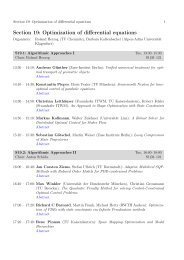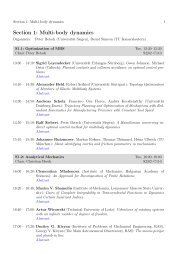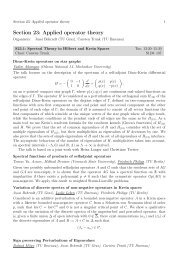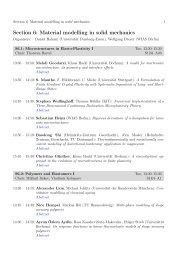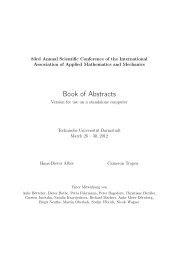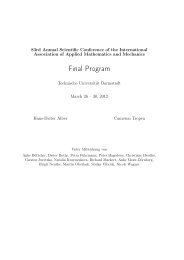Section 6: Material modelling in solid mechanics - GAMM 2012
Section 6: Material modelling in solid mechanics - GAMM 2012
Section 6: Material modelling in solid mechanics - GAMM 2012
Create successful ePaper yourself
Turn your PDF publications into a flip-book with our unique Google optimized e-Paper software.
<strong>Section</strong> 6: <strong>Material</strong> <strong>modell<strong>in</strong>g</strong> <strong>in</strong> <strong>solid</strong> <strong>mechanics</strong> 27<br />
of these criteria and the flow rule.<br />
Selection of an appropriate criterion for a specific material is challeng<strong>in</strong>g. The models of Tresca<br />
and Schmidt-Ishl<strong>in</strong>sky, represent<strong>in</strong>g two regular hexagons <strong>in</strong> the π-plane, def<strong>in</strong>e accord<strong>in</strong>gly the<br />
lower and the upper limit of convexity. The criteria of Sokolovskij and Ishl<strong>in</strong>sky-Ivlev describe<br />
the regular dodecagons <strong>in</strong> the π-plane and have only geometrical mean<strong>in</strong>g. In difference to these<br />
four criteria, the model of von Mises has no s<strong>in</strong>gular corners and delivers unique results by the<br />
stra<strong>in</strong> rates calculation.<br />
The evaluation of the measurements shows that the material behavior differs from the idealized<br />
models. The models proposed by Drucker, Dodd-Naruse, Edelman-Drucker and Hershey aim to<br />
better adapt the flow surface. These models are the functions of one parameter. They have no<br />
claims on the generality and are used only for the approximation of the measurements.<br />
Three models with one parameter are known as generalized models: Unified Yield Criterion<br />
(UYC) of Yu, Bi-Cubic Model (BCM), and Multiplicative Ansatz (MA) [1]. These models <strong>in</strong>clude<br />
the models of Tresca and Schmidt-Ishl<strong>in</strong>sky. They allow approximat<strong>in</strong>g of exist<strong>in</strong>g measurements<br />
better than other models.<br />
This work compares the flow criteria. For this aim their geometries <strong>in</strong> the π-plane will be<br />
considered <strong>in</strong> polar coord<strong>in</strong>ates R and ϕ. The radii of the surface at the angles of ϕ = 15 and<br />
30 ◦ are related to the radius at ϕ = 0 ◦ : h = R(15 ◦ )/R(0 ◦ ), k = R(30 ◦ )/R(0 ◦ ). On the basis of<br />
these two relations, well-known criteria will be systematized and shown <strong>in</strong> the h − k–diagram.<br />
New criteria will be <strong>in</strong>troduced. The convexity limits for them will be stated.<br />
From the h−k–diagram, it is clear that UYC and MA set left and right boundary of convexity.<br />
Thus, the extreme solutions for parts can be found. The two models UYC and MA are the<br />
functions of the parameter k. The l<strong>in</strong>ear comb<strong>in</strong>ation of UYC and MA provides a universal model<br />
with two parameters k and ξ ∈ [0, 1] describ<strong>in</strong>g all convex surfaces of <strong>in</strong>compressible material<br />
behavior of hexagonal symmetry <strong>in</strong> the π-plane.<br />
The proposed consideration of the flow criteria simplifies the selection of the model and is<br />
suitable for didactic purposes. All known and new flow criteria can be described by universal<br />
model, and thus can be omitted.<br />
[1] Kolupaev, V. A., Altenbach, H.: Considerations on the unified strength theory due to Mao-<br />
Hong Yu, Forschung im Ingenieurwesen 74(3), (2010).<br />
S6.11: Special Methods <strong>in</strong> <strong>Material</strong> Model<strong>in</strong>g Thu, 16:00–18:00<br />
Chair: Bernhard Eidel, Markus Scholle S1|01–A03<br />
Model<strong>in</strong>g of Carbon Nanotubes by Molecular Mechanics<br />
Oliver Eberhardt, Thomas Wallmersperger (TU Dresden)<br />
Carbon Nanotubes (CNTs) are structures <strong>in</strong> the nanoscale consist<strong>in</strong>g of carbon atoms which are<br />
arranged <strong>in</strong> a hexagonal lattice. Hence, they can be imag<strong>in</strong>ed as a plane sheet of graphene rolled<br />
<strong>in</strong>to a seamless tube. By do<strong>in</strong>g so we obta<strong>in</strong> a so called S<strong>in</strong>gle Wall Carbon Nanotube (SWCNT).<br />
Besides S<strong>in</strong>gle Wall Carbon Nanotubes also Double Wall Carbon Nanotubes (DWCNT) and, <strong>in</strong><br />
general, Multi Wall Carbon Nanotubes (MWCNT) exist. Their high stiffness and active deformation<br />
of approx. 1 % at applied low electric voltages (approx. 1 V) make the Carbon Nanotubes a<br />
very promis<strong>in</strong>g material for applications e.g. <strong>in</strong> new classes of composites and actuators/sensors.<br />
In this research the approach to model Carbon Nanotubes is made by us<strong>in</strong>g molecular <strong>mechanics</strong>.<br />
The aim of these efforts is to determ<strong>in</strong>e the mechanical properties, for example the Young’s



